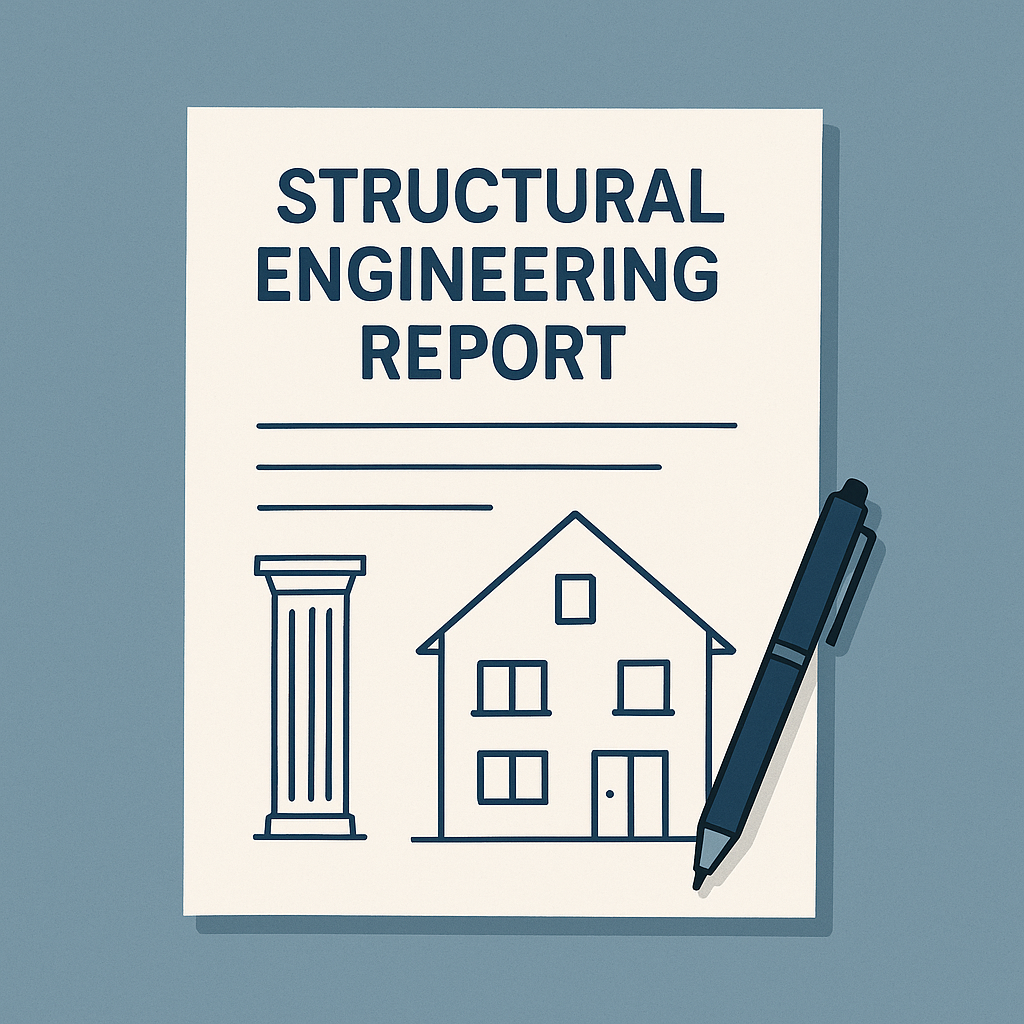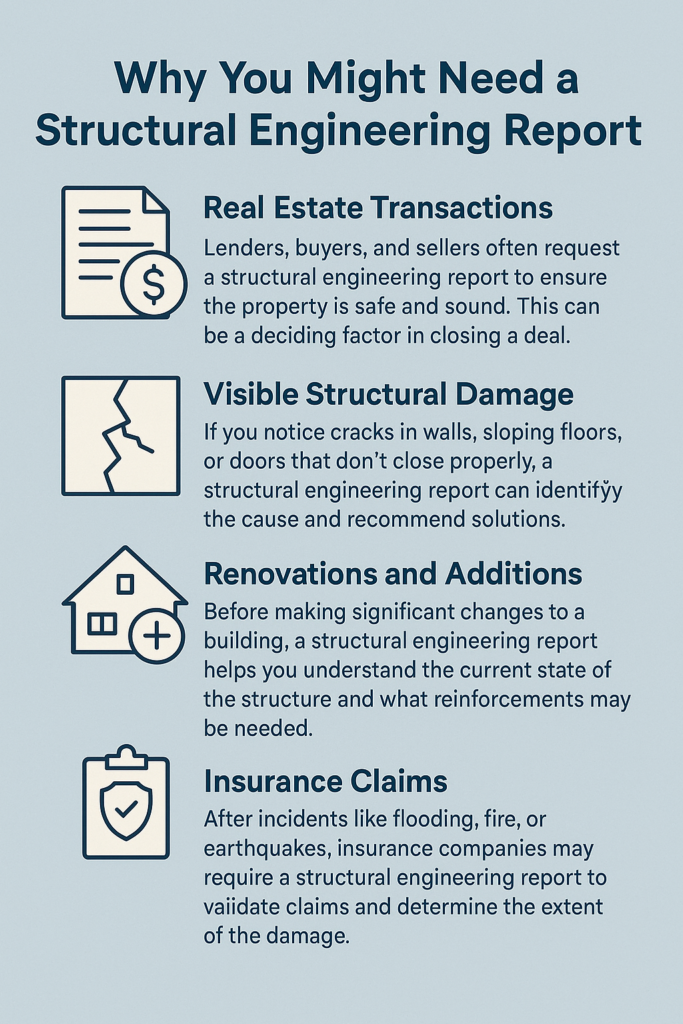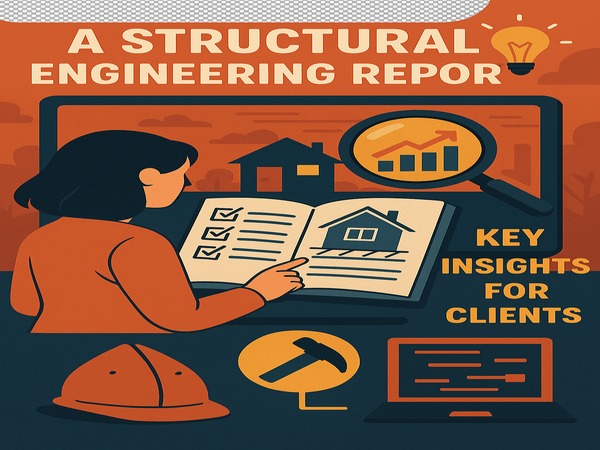Understanding a structural engineering report is essential for anyone who owns, manages, or is considering purchasing a property. These reports are the backbone of building safety, providing a professional assessment of a structure’s integrity, highlighting any issues, and offering clear recommendations for repairs or improvements. However, many property owners find these reports overwhelming due to their technical nature. This guide will help you confidently navigate your next structural engineering report, so you can make informed decisions about your property.
What Is a Structural Engineering Report?
A structural engineering report is a formal document prepared by a licensed structural engineer after inspecting a building or structure. The report’s main purpose is to evaluate the condition of the structure, identify any defects or safety concerns, and recommend necessary actions. Whether you’re dealing with a residential home, commercial building, or industrial facility, a structural engineering report provides a snapshot of the structure’s health and safety.
These reports are often required in situations such as:
- Buying or selling a property
- Noticing visible damage (cracks, sagging, uneven floors)
- Planning renovations or extensions
- Filing insurance claims after damage from events like storms or earthquakes

Why You Might Need a Structural Engineering Report:-
There are several scenarios where a structural engineering report is not just helpful, but essential:
1. Real Estate Transactions:
Lenders, buyers, and sellers often request a structural engineering report to ensure the property is safe and sound. This can be a deciding factor in closing a deal.
2. Visible Structural Damage:
If you notice cracks in walls, sloping floors, or doors that don’t close properly, a structural engineering report can identify the cause and recommend solutions.
3. Renovations and Additions:
Before making significant changes to a building, a structural engineering report helps you understand the current state of the structure and what reinforcements may be needed.
4. Insurance Claims:
After incidents like flooding, fire, or earthquakes, insurance companies may require a structural engineering report to validate claims and determine the extent of the damage.
5. Routine Safety Checks:
For older buildings or those exposed to harsh conditions, regular structural engineering reports can help prevent major issues by catching problems early.

Key Sections of a Structural Engineering Report:-
A structural engineering report is typically organized into several key sections. Understanding these sections will help you make sense of the findings and recommendations.
1. Executive Summary
This is a concise overview of the inspection, highlighting the most important findings and immediate recommendations. The executive summary is written in plain language for quick reference, making it a great starting point for property owners.
2. Introduction and Scope
This section explains why the report was commissioned, who requested it, and the specific areas or components inspected. It also outlines any limitations, such as inaccessible areas or weather conditions that may have affected the inspection.
3. Methodology
Here, the engineer describes how the inspection was conducted. This might include visual assessments, measurements, non-destructive testing, and reference to building codes or standards. Understanding the methodology can give you confidence in the thoroughness of the report.
4. Observations
This is the core of the structural engineering report. The engineer documents all findings, including any visible defects, areas of concern, or unusual conditions. Each observation is typically supported by photographs and sometimes diagrams.
5. Analysis
In this section, the engineer explains the significance of the observed issues, their likely causes, and the potential impact on the building’s safety and performance. The analysis often includes references to engineering principles and building codes.
6. Recommendations
Based on the observations and analysis, the engineer provides clear, actionable recommendations. These may include immediate repairs, ongoing monitoring, or further investigation. Recommendations are usually prioritized by urgency.
7. Supporting Documentation
A thorough structural engineering report includes supporting materials such as photographs, annotated diagrams, calculations, and references to relevant standards. These help clarify the findings and recommendations.
Common Terms in a Structural Engineering Report:-
Structural engineering reports often contain technical language. Here are some common terms you might encounter, along with their meanings:
- Load-Bearing Wall: A wall that supports the weight of the structure above it.
- Settlement: The gradual sinking of a building, which can cause cracks or uneven floors.
- Deflection: The amount a structural element bends under load.
- Spalling: The flaking or breaking off of concrete, often due to moisture or corrosion.
- Shear: A force that causes parts of a material to slide past each other in opposite directions.
- Lateral Movement: Sideways shifting of a structure, often due to wind or seismic activity.
- Foundation Failure: When the base of a structure can no longer support its load.
Understanding these terms will help you better interpret your structural engineering report and communicate effectively with your engineer or contractor.

How to Interpret the Findings:-
A structural engineering report can seem daunting at first glance, but focusing on a few key areas will make it much more manageable:
1. Assess the Severity of Issues
Engineers typically categorize issues as minor, moderate, or severe. Pay close attention to anything labeled as “urgent” or “requires immediate attention.” These are the issues that could pose safety risks or lead to costly repairs if not addressed promptly.
2. Review the Recommendations
The recommendations section is your action plan. It may include:
- Immediate repairs (for critical safety issues)
- Monitoring (such as tracking the width of a crack over time)
- Further investigation (like soil testing or opening up walls)
Prioritize actions based on urgency and your budget.
3. Understand the Limitations
Every structural engineering report has limitations, such as areas that were inaccessible during the inspection. Be aware of these, as they may require follow-up assessments or additional inspections.
4. Use Photographs and Diagrams
Visual aids included in the report can help you locate and understand the issues described. If you’re unsure about what you’re seeing, ask your engineer for clarification.
What to Do After Receiving Your Structural Engineering Report:-
Once you receive your structural engineering report, it’s important to take the right steps to address any issues and protect your investment:
1. Review the Executive Summary
Start with the executive summary to get a high-level understanding of the findings and recommendations.
2. Discuss the Report with Your Engineer
If anything in the structural engineering report is unclear, schedule a meeting or call with the engineer who prepared it. They can explain technical terms, prioritize actions, and answer your questions.
3. Obtain Repair Quotes
Use the recommendations section to get quotes from qualified contractors. Share the relevant parts of the structural engineering report to ensure accurate estimates and appropriate repair methods.
4. Plan Repairs or Further Investigations
Address urgent issues as soon as possible to ensure safety. For less critical recommendations, plan repairs based on your budget and schedule. If further investigations are advised, arrange for them promptly to avoid delays.
5. Keep Records
Store your structural engineering report and all related documents in a safe place. These records will be valuable for future reference, especially if you plan to sell or renovate the property.
FAQs:-
Q1: How much does a structural engineering report cost?
A: The cost depends on the size and complexity of the property but typically ranges from $500 to $2,500.
Q2: How long does it take to receive a structural engineering report?
A: Most reports are delivered within 3 to 7 business days after the inspection.
Q3: Can I use a structural engineering report for insurance claims?
A: Yes, insurance companies often require a structural engineering report to process claims related to structural damage.
Q4: What if I disagree with the findings in my structural engineering report?
A: You can seek a second opinion from another licensed structural engineer for confirmation or clarification.
Q5: How often should I get a structural engineering report?
A: It’s recommended after major events (like earthquakes), before buying or selling, or if you notice signs of structural distress.
Conclusion:-
A structural engineering report is a powerful tool for ensuring the safety, value, and longevity of your property. By understanding the structure, terminology, and recommendations in your report, you can make informed decisions about repairs, renovations, or purchases. Don’t hesitate to consult with your engineer if you have questions, and always act promptly on urgent recommendations to protect your investment.
If you need help interpreting your structural engineering report or want expert guidance on your next steps, our team of experienced consultants is here to assist you. Reach out today for a clear, actionable review and peace of mind about your building’s future.
Read More On:-
For more information about engineering, architecture, and the building & construction sector, go through the posts related to the same topic on the Specuwin Blog Page.
Find out more accurately what we are going to take off in the course of applying leading new technologies and urban design at Specuwin.
